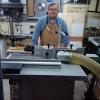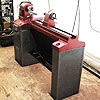I need to upgrade and add some tools in my shop. I currently have a small tabletop router table and misc hand held units for most applications, but want to get a larger more permanent mounted router station and or shaper. My question is what is the best system out there for a router table/cabinet for use with the smaller 1/4, and 1/2 Colet bits with easy to use cutting depth adjustment? And should I invest in a 3-HP shaper for running additional molding profiles at a higher production speed w/auto-feed options? My feeling is yes but wanter to get others take or opinion on size, type, and brand. Grizzly seems to be a popular brand but is the quality there? Most all of the other tools in my shop are of high quality, and I would rather spend a little more now and have something that will last a lifetime so to speak and be able to repair it if needed years down the road.
Any and all comments and suggestions are welcome. Thank you in advance for assisting me in this decision.
Troy





 Reply With Quote
Reply With Quote












